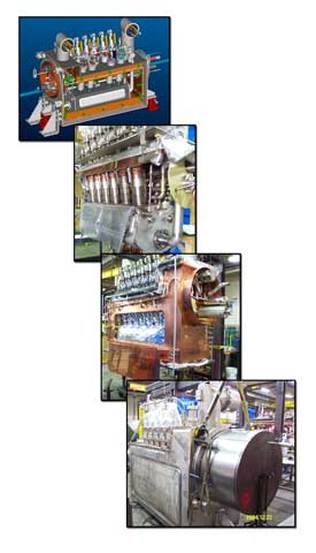Call: 708-425-9080
Firing Up the LHC
Lawrence Berkeley National Laboratory News Center, June 12, 2008
Berkeley Lab Accelerator Scientists and Engineers Anticipate the Start-Up of CERN's Large Hadron Collider
CERN, the European Center for Nuclear Research, is headquartered in Geneva and occupies regions of both Switzerland and France, but in addition to its European members countries around the world including the U.S. and Japan have made substantial contributions to CERN's giant new accelerator. The Large Hadron Collider (LHC) will inject its first proton beams in the summer of 2008. An occasion for world-wide celebration, the event will hold special significance for members of Lawrence Berkeley National Laboratory's Accelerator and Fusion Research Division (AFRD), Physics Division, and Engineering Division.
|
"When the LHC turns on it will be the world's most complex scientific instrument and will surely be looked back upon as one of mankind's great achievements," says Steve Gourlay, director of AFRD. "I know that the scientists and engineers here at Berkeley Lab and their colleagues at Fermilab and Brookhaven are grateful for the opportunity to contribute to this incredible project. My congratulations to all of them on the successful culmination of many years of hard work."
The U.S. LHC collaboration's accelerator project is a $110 million undertaking sponsored by the U.S. Department of Energy. Led by Fermilab in Illinois, with major participation by Berkeley Lab and New York's Brookhaven, much of the effort has concentrated on the final focusing magnets that bracket the LHC's four major experiments. The ATLAS, ALICE, CMS, and LHCb experiments are located at the LHC's four interaction points (IPs) — points around the 27-kilometer ring where two counterrotating proton beams, each with an energy of 7 TeV (seven trillion electron volts), will intersect and collide at a center-of-mass energy of 14 TeV, never before attained in a particle accelerator. Fermilab's Jim Strait was the first project manager for the US LHC project. "Essentially we reassembled the collaboration that had worked on the magnets for the SSC" — the Superconducting Super Collider, cancelled by Congress in 1993 — "because among our three labs we'd developed considerable expertise in superconducting magnets," Strait says. |
|
Although the complex DFBX design took longer than scheduled, the lost time was made up in production. Rasson credits Meyer Tool & Manufacturing, Inc. (MTM), near Fermilab, for fabricating and assembling the vessels under the direction of MTM's vice president for operations, Ed Bonnema.
At two of the interaction regions, those at the ATLAS and CMS experiments, other important components of the focusing assemblies serve quite a different purpose. When particle beams collide, things fly out, the reason for arranging collisions inside the experiments in the first place. But much of this debris is traveling in the direction of one beam or the other and flies right on down the tube and out the ends of the experiment. To keep this intense radiation from overheating and quenching the focusing magnets — that is, causing them to lose superconductivity and calamitously release their stored energy — two kinds of absorbers soak it up. The Target Absorber Secondaries (TASs) are closest to the experiment and absorb the flux of high-energy charged particles (and some neutral ones) as they leave the interaction point. A TAS also shields the detectors themselves from any unfocused beam particles headed the other way, into the experiment. Each TAS weighs over three metric tons. Jim Strait remarks that Bill Turner, the now-retired AFRD physicist who led Berkeley Lab's overall participation in the US LHC project, regarded the TAS as a particular challenge to the effort. "Turner remarked that the TASs had to be aligned to within a fraction of a millimeter — yet because they are housed inside hundreds of tons of shielding at the ends of the experiments, you can't even see them!" Turner's real interest was accelerator physics, says Joseph Rasson. "He took on the engineering of the final-focus components because he saw an opportunity to participate in the biggest accelerator of the age." Out beyond the triplets, just in front of the D2 dipole magnets, are more absorbers, the Target Absorber Neutrals (TANs). Neutrons and photons aren't readily diverted by electromagnetic forces and travel this distance — over 140 meters from the interaction point — while retaining enough energy to quench the D2 dipole, where the ingoing and outgoing beams transition between two separate beam pipes to one and move closely in parallel. The bifurcation happens inside the TAN, whose shielding and absorption requirements are stern enough to require a 30-metric-ton mass of metal |
|
"With all this beam power concentrated on a small spot, there is not only a need for massive shielding and great precision, but also an opportunity for a very precise measurement of beam intensity," says Strait. "So inserting instrumentation here was a natural, but Turner and his colleagues had the foresight to allow for extra instrumentation that might come later. Today a lot of experimenters are finding ways to make use of this opportunity."
The TAN's instruments for monitoring accelerator operations include measuring beam luminosity, the separation and position of the two beams in the pipe, and other parameters. Berkeley Lab designed and built these instruments and other elements, including beam pipes and lead conductor conduits, in its own engineering facilities or through commercial contracts. TAS and TAN fabrication was begun by Egon Hoyer, now retired, and taken over by Bill Elliott, now at Livermore; both are mechanical engineers. Well before the TAS, TAN, and DFBX pieces were shipped to CERN to be lowered into the tunnel and assembled in situ, Berkeley Lab engineer Ron Scanlon, now retired, and members of the Lab's Superconducting Magnet Group headed by Gourlay of AFRD had contributed to the design of the superconducting cables for magnets in the LHC's main ring, plus supplying superconducting cable for the triplets. Most of the Lab's work on these and other aspects of the LHC had apparently been wrapped up by the spring of 2007. Then, during a high-pressure test of a triplet at the CMS interaction point, one of the three quadrupole magnets failed when its "cold mass," containing the magnet coils, broke loose. |








